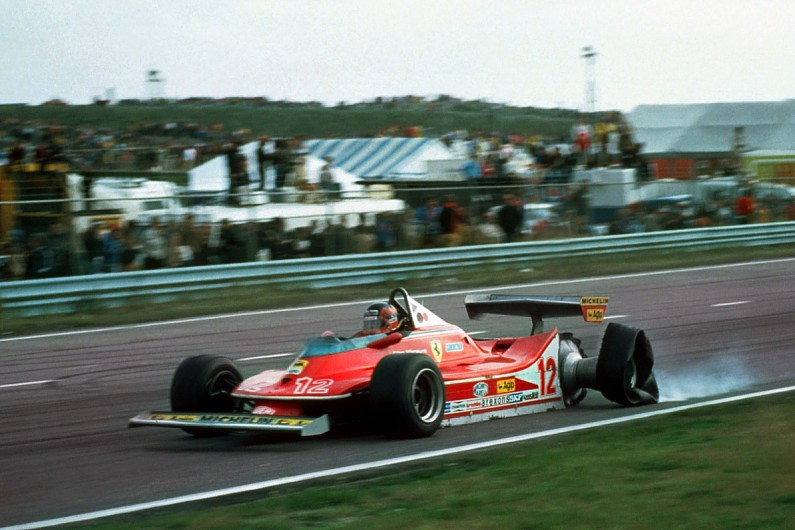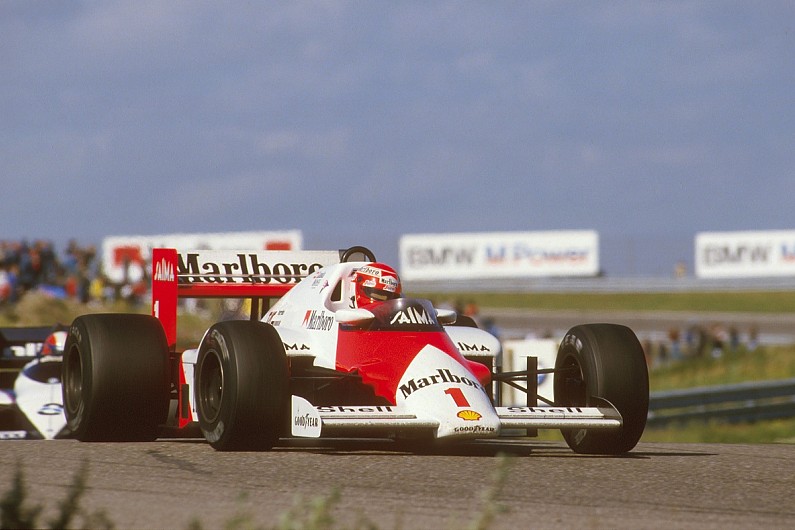It’s long-awaited return to the Formula 1 calendar has been put on hold, but the Dutch GP’s rich history – pre-dating the world championship by two years – means it rightfully deserves its place. We picked six of the best moments from its 34 editions.
The Dutch Grand Prix was supposed to return this weekend. The Formula 1 circus was going to visit Zandvoort for the first time since 1985, but the coronavirus pandemic has meant that Max Verstappen will have to wait a bit longer to perform for Red Bull in front of his home fans.
The seaside venue has a history stretching right back to the beginning of F1 and has hosted some great races, titanic struggles and fine moments. It has had its tragedies too, most notably the deaths of Piers Courage and Roger Williamson in the 1970 and 1973 Dutch GPs respectively.
But with such a chequered past, Zandvoort and its greatest moments were well worth putting under the microscope, even if no one can be there this weekend.
Early standouts
Work on Zandvoort began during World War Two, and the British Racing Drivers’ Club organised the first meeting on 7 August 1948. Prince Bira’s Maserati won the Zandvoort GP by just 0.1 seconds from the Alfa Romeo of Tony Rolt, and the following year’s event attracted a strong field that included factory Ferraris.
Perhaps the finest contest before Zandvoort joined the world championship calendar came in 1950, with the big race now named the Dutch GP. The pacesetting Alfa Romeos were not entered, but an Italian victory still looked likely, with Juan Manuel Fangio and Froilan Gonzalez both present in Maseratis.
French ace Raymond Sommer nevertheless took pole in his Talbot-Lago and repassed Fangio, who was struggling with suspension issues, in the early stages. Sommer’s clutch eventually failed him, but still there was a surprise as Louis Rosier – victor of the Le Mans 24 Hours a month before – came through to win the 90-lap contest, beating the Ferraris of Luigi Villoresi and Alberto Ascari by over a minute in his Talbot-Lago.
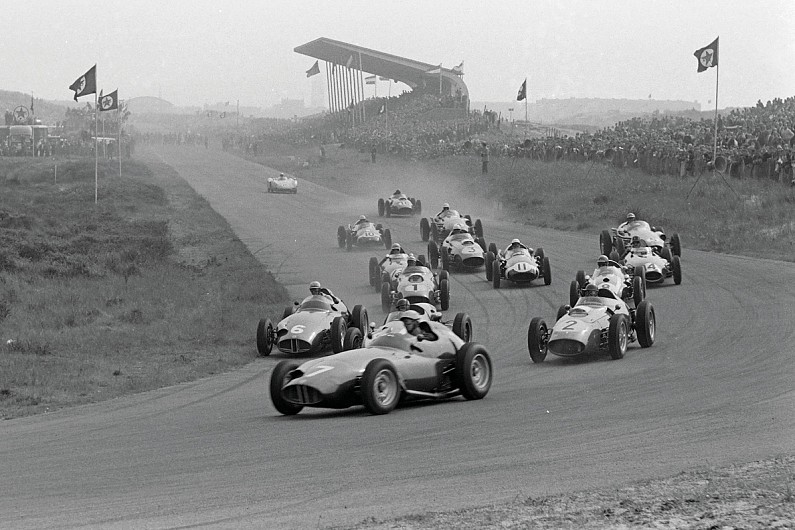
1. BRM’s breakthrough – 1959
The Dutch GP became part of the world championship in 1952, and for the next few years – aside from 1954, 1956 and 1957 when the race was not held – domination was the name of the game. Ascari led every lap in 1952 and 1953 for Ferrari; the Fangio-Stirling Moss Mercedes ‘Train’ left the rest behind in 1955; and Moss thrashed the opposition for Vanwall in 1958.
Bonnier’s fine effort looked like it would go unrewarded when Moss took the lead, but the Rob Walker-run Cooper then succumbed to gearbox failure, leaving Bonnier to take his only world championship F1 victory
The 1959 Dutch GP, however, was different. For nearly a decade BRM had been something of a disaster. Initially all the hopes of the British (motorsport) industry had rested with British Racing Motors, but the failure of the overly complicated V16 and fragility of the promising P25 had long since resulted in the endeavour being labelled a shambles.
The team persevered under Alfred Owen, and the Tony Rudd-designed car, which had first appeared in 1955, finally came good in 1959. A great deal of testing preceded Jo Bonnier’s Zandvoort pole position, and the Swede battled the Coopers of first Masten Gregory and then Jack Brabham, gaining the advantage when each developed gearbox issues.
Bonnier’s fine effort looked like it would go unrewarded when Moss took the lead on lap 60 of 75, but the Rob Walker-run Cooper then succumbed to gearbox failure, leaving Bonnier to take his only world championship F1 victory. It was also the first of BRM’s 17 wins; three years later it would win the drivers’ and constructors’ titles.
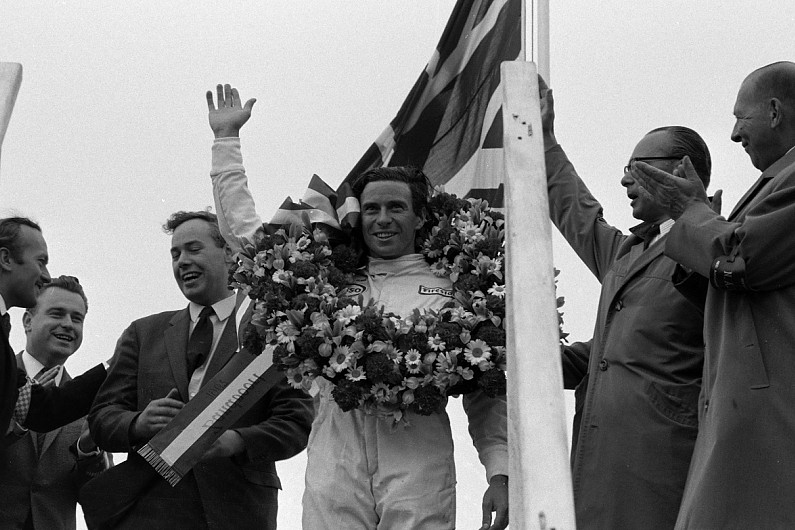
2. Two new eras begin – 1967 and 1968
Jim Clark and Lotus had a certain affinity with Zandvoort. The revolutionary monocoque Lotus 25 had made its debut in the 1962 Dutch GP, and Clark scored a hat-trick from 1963 to 1965. He also put in one of his greatest drives, with two-litre Climax power against the three-litre Brabham Repcos, in 1966, but it’s the following year’s race that has the most significance.
The debut of the Ford Cosworth DFV probably stands as Zandvoort’s most important moment. Colin Chapman’s Lotus 49, designed to use the DFV as a stressed member, had exclusive use of the powerplant in 1967, and Graham Hill took pole by half a second on the car’s debut.
He led before retiring with a broken camshaft drive, but team-mate Clark – who had suffered a troubled practice and started eighth – had already climbed to fourth and now inherited third place. He continued his charge and, on lap 16 of 90, overtook Brabham for the lead. Clark then nursed the new car to a 23.6s victory, the first of 155 world championship GP wins for the DFV and its derivatives.
The following year’s Dutch GP could also be regarded as the start of a new era. Benchmark driver Clark had been killed in a Formula 2 race at Hockenheim less than three months before round five of the championship, leaving a vacuum at the top of the sport.
Jackie Stewart, who had missed two of the three intervening GPs due to injury, indicated that he would be the man to take over at the top with a superb victory at a wet Zandvoort.
The Scot qualified down in fifth in his DFV-powered Matra, but took the lead on lap four. On a day when the Dunlop runners had an advantage, Stewart quickly pulled away.
Only Jean-Pierre Beltoise (V12 Matra) could get anywhere near his times but, almost as soon as he got into second, he went off, pitted to have his throttle slides checked, and had to do it all again. He did, but still finished a minute and a half behind a cruising Stewart.
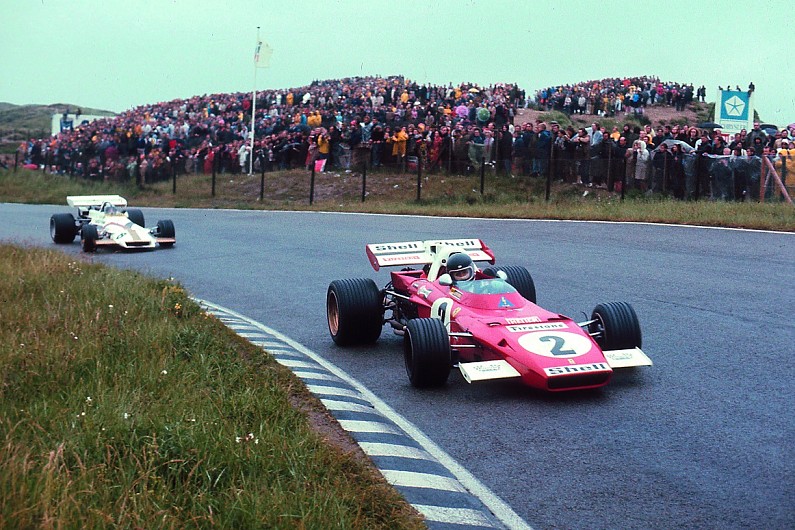
3. Duel of the rainmasters – 1971
Aside from Stewart, the other two rainmasters of the time were Jacky Ickx and Pedro Rodriguez. And they provided the rare sight of a race-long wet-weather battle in the 1971 GP. Firestone-shod cars dominated this time, and Ickx’s Ferrari and the BRM of Rodriguez proved to be the class of the field.
Ickx grabbed the lead back on lap 30 of 70, Rodriguez retaliated in traffic the next time around, and then the Ferrari moved ahead once more on lap 32
The duo proved incredibly close in dry qualifying, Ickx taking pole by just 0.04 seconds, and the Ferrari maintained its lead at the start as they quickly pulled clear. After two laps, third man Stewart – struggling with inferior Goodyear rubber and braking issues on his Tyrrell – was nearly nine seconds behind Rodriguez.
On lap nine, the leaders came upon an incident involving Francois Cevert and Nanni Galli at Tarzan, and Rodriguez took the opportunity to snatch the lead. The BRM pulled away over the next few laps, at one stage building an advantage of over eight seconds, but then Ickx started to close the gap, the Ferrari pulling better out of the slower corners as the circuit dried.
Ickx grabbed the lead back on lap 30 of 70, Rodriguez retaliated in traffic the next time around, and then the Ferrari moved ahead once more on lap 32. “It was all real Formula 1 racing, and the damp crowd loved it,” reported Autosport’s Patrick McNally.
Ickx started to pull away, though he tended to be more cautious in traffic than his pursuer, Rodriguez keeping up the pressure. With 11 laps to go, Ickx was 15.6s ahead but – with oil down – the Ferrari driver was more cautious in the closing stages than Rodriguez, who was only eight seconds behind at the flag.
Everyone else was lapped.
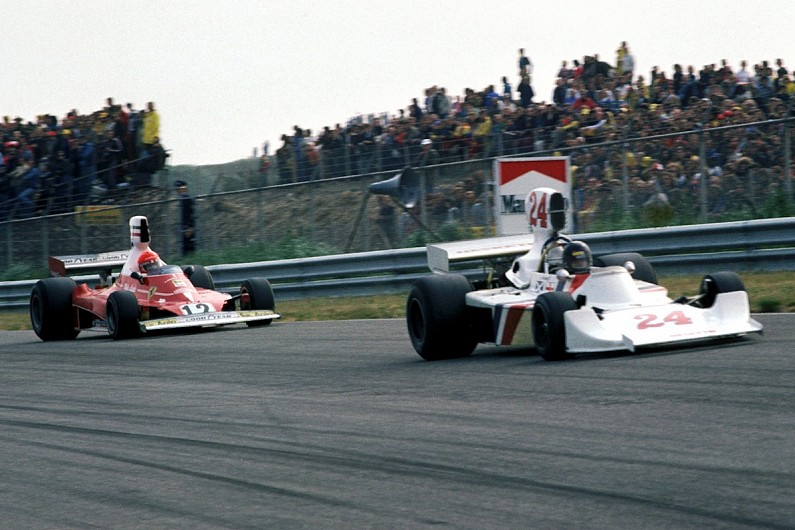
4. Hunt’s breakthrough – 1975
Niki Lauda and Ferrari were on fine form when F1 arrived for the 1975 Dutch GP, having won the previous three rounds. That trend seemed set to continue when Lauda took pole, with team-mate Clay Regazzoni alongside, but more North Sea rain on race day provided an opportunity for others to shine.
James Hunt’s Hesketh had managed to lead the incredibly tight DFV-powered brigade in practice, and he ran fourth in the early stages as Lauda led. Hunt had previously noticed that slick tyres worked better on a drying track than most thought, and he was one of the first to get rid of his grooved rubber.
“Lauda and most of the field stopped a good bit later than me,” said Hunt years later, when selecting the drive as the race of his life. “Once ahead, I gave it everything.
“By the time Jean-Pierre Jarier and Lauda got their tyres hot and got used to the track conditions, I had a 10-second lead. From then on they were slowly catching me because the Hesketh was not a fully competitive car.”
Once Lauda had finally got clear of Jarier’s Shadow he closed on Hunt and, for the final third of the race, applied pressure to the leader. But Hunt, on a dry set-up compared to Lauda’s compromised 312T, held firm to win by a second.
Hunt felt it was a key drive that ended his weakness of making mistakes while leading: “That was the completion of my training as an F1 driver. It enabled me to win the 1976 championship, at my first and only chance in a competitive car, under maximum pressure.”
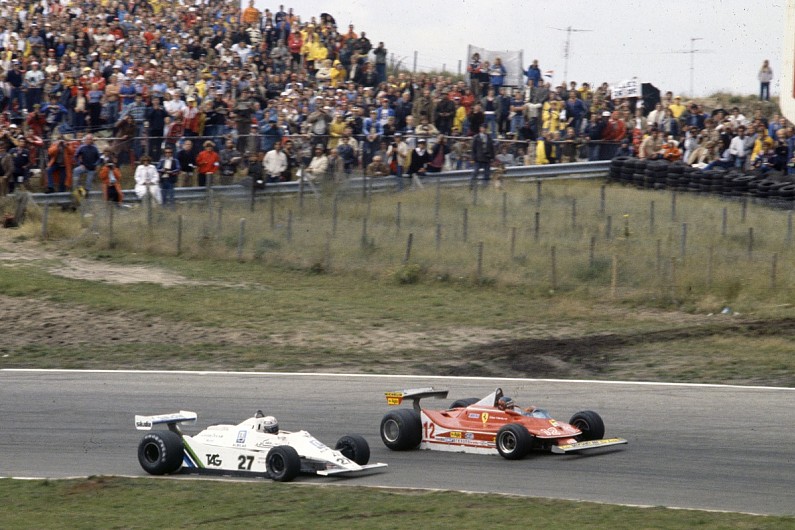
5. Villeneuve misses the point – 1979
Gilles Villeneuve is regarded as one of the finest F1 drivers never to win the world title, and his 1979 Dutch GP drive perhaps showcased the best and worst traits of the Ferrari driver.
Villeneuve made a typically rapid getaway to jump from sixth to second, and chased the Williams of Alan Jones in the early laps. He then pulled off a superb pass at Tarzan, getting alongside under braking and then going all the way around the outside to complete the move.
Had he pitted for fresh rubber, Villeneuve would have finished at least in third position, possibly second – instead, his dramas put Scheckter into a position that enabled him to clinch the title
He edged away, but then picked up a slow puncture and Jones closed back in. Villeneuve then spun at the new high-speed chicane, brilliantly keeping the car out of the barriers but losing the lead. If his slow puncture had not been apparent before, surely it would have been now, but he pressed on – and suffered a left-rear tyre failure a lap and a half later at Tarzan.
The image of Villeneuve three-wheeling (or, at times, two-wheeling) became iconic, but the whole saga cost him any chance of a points finish. Had he pitted for fresh rubber he would have finished at least in third position, possibly second.
By contrast, Villeneuve’s Ferrari team-mate and fellow title contender Jody Scheckter drove one of his great races after suffering an overheating clutch at the start. He moved aside to avoid getting hit, dropping to the back of the field.
Scheckter then got the car going, nursed it by not using the clutch for the first couple of laps, and then began a charge. After 10 laps he was sixth, and he pulled a move on Didier Pironi’s Tyrrell at Tarzan that was very similar to Villeneuve’s pass on Jones.
He then easily overcame Keke Rosberg’s Wolf, and inherited third when Jean-Pierre Jabouille’s Renault retired with clutch problems.
“I was getting out of shape, doing some pretty ambitious outbraking moves in my determined efforts,” said Scheckter.
Villeneuve’s dramas allowed Scheckter to take second, putting him in a position that enabled him to clinch the title – with Villeneuve’s help – next time out in the Italian GP at Monza.
6. Lauda’s last victory – 1985
By 1985, ‘noise pollution’ was becoming an issue and the circuit was looking a little the worse for wear, but still it provided some good racing. That was proved by the battle between McLaren team-mates Lauda and Alain Prost.
Tim Wright was Prost’s engineer and he takes up the story: “This was the 11th race on the calendar and we came to the race fighting for both drivers’ and constructors’ championships. Prost had just won the previous race in Austria to put himself equal on points with Michele Alboreto in his Ferrari, so we were hoping the trend would continue.
“Lauda had not enjoyed much success up until this race, only scoring points in two races, although he had showed that he was still up for the fight in Austria, where he led Prost for 14 laps before again suffering an engine problem.
“As usual, Goodyear had brought the two compounds of tyre – the B and C – for the race and, although the track was notoriously abrasive, we were confident that, as the McLaren was kind on its tyres, we could get away with running the softer C compound.
“Both drivers suffered low power during qualifying, Prost having a malfunctioning pop-off valve to leave him third on the grid, with Lauda back in 10th as it transpired he only had five of the six Porsche/TAG cylinders working properly.
“During the year we had numerous problems with pop-off valves, as they were under the control of the FIA, but were totally inconsistent in their calibration and performance. It was a regular trip to their offices to have valves replaced.
“Pole position was taken by Nelson Piquet in his Brabham, with Keke Rosberg second in the Williams, but we were pleased to see the Ferraris struggling on the bumpy surface and had only managed 16th and 17th.
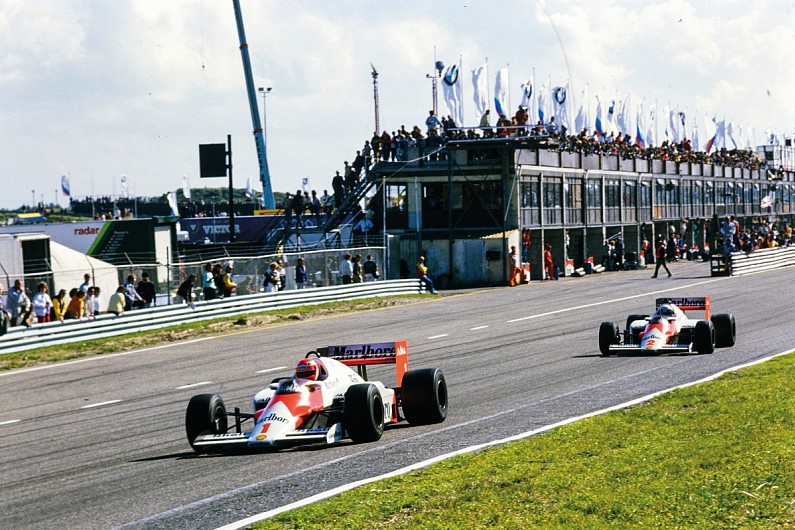
“The engine problems were sorted out for the warm-up on the Sunday morning and this was a pointer for what was to happen come the race, as Niki was quickest ahead of Prost. Piquet caused a bit of confusion at the start when he stalled the Brabham, with the result that Rosberg made a clean break, followed by Ayrton Senna in the Lotus, then Teo Fabi in the Toleman who had appeared from nowhere.
“Niki had made a great start and was right behind Prost in fifth place and had decided that he would push his tyres hard on full tanks and stop earlier. As always, Prost was able to look after his tyres better in a race situation and would go almost to half race distance.
Right on cue, Alain came in for his pitstop on lap 34, but he was stationary for 18s as a wheelnut refused to come off. By the time he was back on track, he found himself behind both Senna and Niki
“He disposed of Fabi and Senna after a few laps and, when Rosberg retired with an engine failure, he assumed the lead and things were looking good. Just before this, Niki had made his pitstop for fresh rubber, and he steadily made his way back through the pack as others fell by the wayside; he was soon up to second place behind Prost.
“Right on cue, Alain came in for his pitstop on lap 34 of 70, but things then went awry as he was stationary for 18s as a wheelnut refused to come off. By the time he was back on track he found himself behind both Senna and Niki.
“There then followed an epic race between both our cars as Alain, once past Senna, set about catching Niki, setting fastest lap after fastest lap, reducing the gap between them, until they were nose to tail. We had never discussed team orders and so there were no radio conversations as we let them fight it out.
“The last 10 laps were nerve-racking for us on the pitwall, but the two drivers put on a magical show, with Niki resisting any move that Alain made, their mutual respect showing just why they were both world champions, although at this point Alain had still not realised his first one!
“Niki had made his point, and no one would begrudge him this win, but it also meant Alain had taken the lead in the championship, which he would not lose.”
It was a fitting way for F1 to sign off from Zandvoort, but hopefully the Dutch fans can look forward to a new chapter of memorable moments when racing finally returns to normal.

